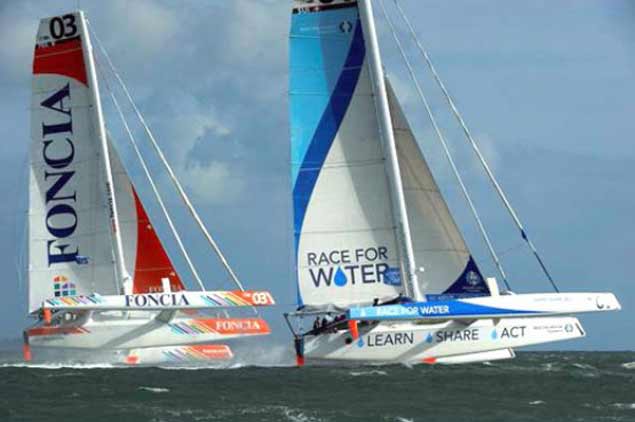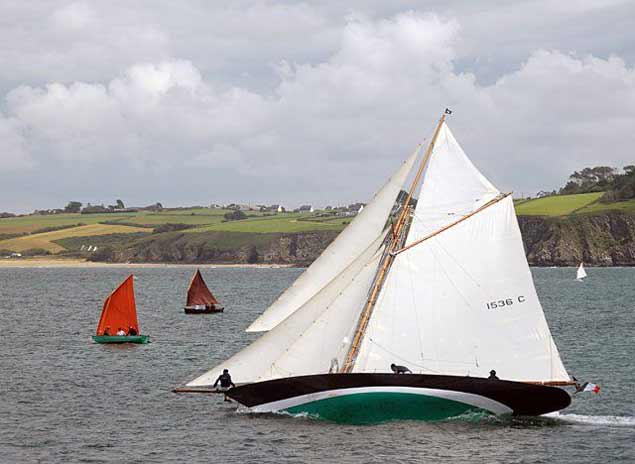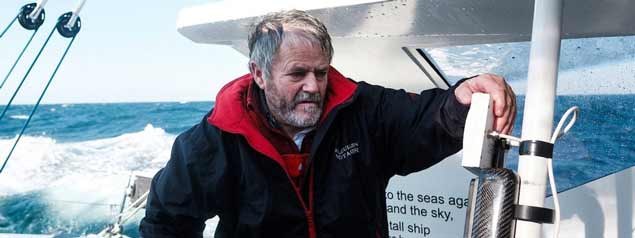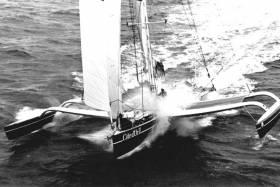Displaying items by tag: Dun Laoghaire Sailing
In a year which has seen sailing headlines frequently dominated by uniquely French events like the Vendee Globe, the Mini-Transat and the Transat Jacques Vabre, we find ourselves analyzing yet again just why France’s special take on our sport seems to hit the spot in setting the global pace. We talk of it as though it’s a relatively new phenomenon. Yet it has been going on for decades. And it was all of thirty years ago that Dun Laoghaire first found itself right at the heart of the Francophile trend in top level sailing. W M Nixon looks back to an event which brought big time sailing sweeping into Dublin Bay.
There’s a group of veteran volunteer enthusiasts in the Royal St George Yacht Club on the Dun Laoghaire waterfront who sometimes wonder did it all really happen. Because, every so often, somebody somewhere announces that the French are becoming world leaders for popular forms of sailing which draw the crowds, and get significant numbers to have a go for themselves in the world of boats and sticks and strings and sails.
But this group in Dun Laoghaire know very well that saying the French “are becoming” the top matelots in a populist sense is way off target. They are very well aware that the French have been in that pole position for at least thirty years. And they have memories – increasingly distant memories, it has to be said, but real memories nevertheless – of the event which brought it all home to them in a forceful way, and it was definitely all of thirty years ago.
 The MOD 70s cutting the mustard in Dublin Bay, September 2012. Photo: David O’Brien/Afloat.ie
The MOD 70s cutting the mustard in Dublin Bay, September 2012. Photo: David O’Brien/Afloat.ie
Since then, of course, we’ve had the Round Europe Race of 1993 come to Dun Laoghaire. Then there was the unforgettable visit of the MOD 70 trimarans in 2012. And when you really want to serve up something with international appeal, Dun Laoghaire has become a venue of choice for the world Laser class.
Then too, the old granite pond serves up the biennial Volvo Dun Laoghaire Regatta, with an enviable style much appreciated by connoisseurs. But that said, when you want something which rings the bells across the sailing world, it’s the French who seem to know how best to do it, and in the popular mind it all goes back to one man, Eric Tabarly (1931-1998), who leapt to fame when he won the second Single-handed Transatlantic race from Plymouth to Newport in Pen Duick II – built to his own specifications – in 1964.
Until then, despite the rugged seamanlike reputation of Breton fishermen, the perception was that France was not really a maritime nation at all, despite having long coastlines all the way from the North Sea to the southeast corner of the Bay of Biscay, and along the Mediterranean.
But after World War II with its soul-destroying German occupation, veterans of the Resistance established the Glenans Sailing School in Brittany in 1947 to put spirit back into French youth, and by the early 1960s a new seafaring enthusiasm was in evidence in France. Eric Tabarly appeared on the scene - a young, square-jawed French naval officer, he was as brave as a lion, and in the open ocean, he could outsail the Anglophone and Nordic nations.
 Cometh the hour, cometh the man – Eric Tabarly was the perfect nautical hero for France in 1964
Cometh the hour, cometh the man – Eric Tabarly was the perfect nautical hero for France in 1964
 The pet boat – the Tabarly family’s Fife cutter Pen Duick was built at Carrigaloe on Cork Harbour in 1898
The pet boat – the Tabarly family’s Fife cutter Pen Duick was built at Carrigaloe on Cork Harbour in 1898
In the end, it could be argued that France expected too much of him. His greatest pleasure was either in sailing his family’s 1898-built (in Cork) Fife cutter Pen Duick, or in developing his own specialist boats to his own concepts, and racing them single-handed or with a carefully-chosen crew of like-minded friends. But when he first came to Dun Laoghaire in 1987 after a dozen years as the leading icon of French sailing, he was racing as a visiting skipper on the big highly-sponsored trimaran Cote d’Or III, and he didn’t seem too comfortable in the role, while Cote d’Or certainly wasn’t winning.
Yet Tabarly’s aura is such that the fact that he raced to Dublin Bay thirty years ago is what most people remember of an extraordinary event for Dun Laoghaire. It had all started because Dun Laoghaire-Rathdown was twinned with Lorient in Brittany, and as the sailing representative on the Twinning Committee, Howard Knott of RStGYC found himself being invited to see what Dun Laoghaire could do as a stopover port for a Round Europe Race for giant multi-hulls sponsored by Swiss watch-maker Tag Heuer.
 The Tag Heuer Round Europe Race of 1987 was symbolic of a time of heady optimism for the European Project, and Dun Laoghaire was very much part of it.
The Tag Heuer Round Europe Race of 1987 was symbolic of a time of heady optimism for the European Project, and Dun Laoghaire was very much part of it.
In theory it was an international event, but in reality – just as with the Vendee Globe today – it was the French nautical spirit expressed in yet another way. And to give it validity, Eric Tabarly had to be one of the skippers.
That in turn set buzzers ringing in Dun Laoghaire. The council - with the energetic support of Bord Failte as it was then - gave it their full backing, and Royal St George YC had a very limited count-down period to put the entire reception show together. A committee was rustled up in jig time with Howard Knott, Brian Craig, Owen McNally, Larry Martin, Justin McKenna and Brendan Redmond, with the full backing of Commodore Dermod Ryan, and they set about providing arrangements. This meant that for several days, the old club was to go both public and international, and they did it with elan.
Fourteen multihulls raced, and their port before Dun Laoghaire was Edinburgh. Coming into Dublin Bay, the leader was Jet Services skippered by Daniel Gillard, with Elf Aquitaine sailed by Jean Morrell second. Eric Tabarly wasn’t on the podium, but that didn’t matter - he was in Dun Laoghaire, a living legend.
Thirty years ago, you’re in the previous millennium and a different universe. Once the crews hit port, there was no question of keeping themselves fit for the next leg like today’s athletes – on the contrary, most of them partied to beat the band. Dun Laoghaire’s combination of stately clubhouses and warm hospitality proved irresistible. And as icing on the cake, the hosts even organised that the skippers had a race (with crew provided) in the Water Wags, which was won by Jean Morrell in a relaxed style which made it look as though he had been racing Water Wags all his life, while Gillard was second.
 Memory of lost times. The daily Evening Press of Dublin went to town on the partying which welcomed the Round Europe fleet to Dun Laoghaire in 1987
Memory of lost times. The daily Evening Press of Dublin went to town on the partying which welcomed the Round Europe fleet to Dun Laoghaire in 1987
Then after a coastal race with Asgard II as the Committee Boat, they sailed on to their next port of Lorient, Dun Laoghaire began to put itself together again, and we have all moved on. These days, thirty years seems like eternity – any contemporary situation seems to change by the minute. But some things stay with us, and even though Eric Tabarly’s life ended in 1998 with a tragic seafaring accident when he was lost overboard off the coast of Wales from the hundred-year-old Pen Duick while on passage to the Fife Regatta in Scotland, there remains with us the abiding memory that here was a truly great man.
Certainly in France he is very much an inspiration, and Pen Duick is lovingly preserved, and an active participant in many events. The fact that she was built in Carrigaloe on Cork Harbour in 1898 was often in Tabarly’s thoughts, and when he won the RORC Cowes-Cork Race in 1974 with Pen Duick VI, he made a point of going up to Carrigaloe on a private visit simply to bear witness to the place where his beloved old boat had been created.
 Pen Duick VI, an Andre Mauric design of 1973 with which Eric Tabarly won the RORC Cowes-Cork Race of 1974. While in Crosshaven, he made a point of visiting Carrigaloe on Great Island where the first Pen Duick was built in 1898
Pen Duick VI, an Andre Mauric design of 1973 with which Eric Tabarly won the RORC Cowes-Cork Race of 1974. While in Crosshaven, he made a point of visiting Carrigaloe on Great Island where the first Pen Duick was built in 1898
As for how things have changed generally since the Round Europe fleet came into Dun Laoghaire in 1987, the French are still in their special position, but now instead of merely being there to see it happen, the Irish are much more actively involved.
Before he found his true sailing home in Australia, Gordon Maguire cut quite a dash in the French scene in events like the Tour de France a Voile. And of course Damian Foxall is very much up front in French sailing, while Marcus Hutchinson has established himself there in a singular role on the management side.
Out on the water, we have seen David Kenefick become “Rookie of the Year” in 2013 in the Figaro Solo, and there’s an impressive new wave coming along in the form of the re-directed Nin O’Leary looking to the Vendee Globe, while Tom Dolan is making his mark in the Mini-Transat, and Joan Mulloy is also very much into the French sailing system.
And on a pedestal of his own, there’s the irrepressible unsinkable Enda O Coineen. Only Enda could do what Enda does. But it’s in the French sailing context that he finds the best setting for his special spirit. And it was all of thirty years ago in Dun Laoghaire that it really came home to everyone just how rapidly French sailing was advancing into this future in which we now sail.
 The unsinkable Enda O Coineen racing to international fame in Kilcullen Voyager in the Vendee Globe
The unsinkable Enda O Coineen racing to international fame in Kilcullen Voyager in the Vendee Globe
Where is Dun Laoghaire Sailing's Strategic Plan?
Last November's Afloat.ie article about why Dun Laoghaire yacht clubs needed to put on a united front got a swift – and largely positive – reaction writes David O'Brien. It dealt with some of the fundamental impediments for sailing in the capital’s waters and why the old sailing model no longer works. Stena paid for the harbour and cheap credit put boats in it but with those days over the challenge is to come up with a new way to keep sailing afloat. That article with proposals for change is here.
One criticism was that the piece merely skirted around the real issues; namely the necessity to consolidate some of the clubs and increase public access to the water through publicly-funded initiatives. Others asked for 'practical solutions, with a pathway and timeline'.
Somewhat perplexingly, however, as much as the article put the issue into the public domain, it does not seem to have even made the agenda on the various waterfront clubs’ General Committees.
In one sense, that's no surprise because these voluntary committees are so much under pressure it is sometimes hard for them to get a glimpse at the big picture. One former Commodore tells how he was so buried in human resources, banking, catering and clubhouse issues that 'sailing' per se rarely surfaced as an agenda item at all in his three years at the helm.
So who is in charge of plotting a course for sailing in Dun Laoghaire? Unfortunately, when everyone is in charge, then no one is in charge.
Since 2008, Irish sailing has lost a quarter of its members and the result on sailing in the capital's waters is dramatic. While individual clubs may well have adapted to these changed circumstances, others are still happy to rearrange the deckchairs on the Titanic.
Spike Milligan always maintained: “We haven't got a plan, so nothing can go wrong!” but that's not going to get us out of this jam. In short, without an overall plan for the future, sailing in Dun Laoghaire will be left behind.
Why have we lost a quarter of our fleet? Where did those sailors go? How do we get them back? And most importantly, how do we leave sailing in good shape for the next generation?
Deciding what tack Dun Laoghaire sailing should be on should involve all stakeholders. If club committees are too busy, then it is up to the rest of us to work out a plan. This must be a document that transcends traditional boundaries.
The stakeholders here are not just the waterfront clubs – all the stakeholders have a part to play:
- The waterfront clubs: National Yacht Club (NYC), Royal Irish Yacht Club (RIYC), Royal St George Yacht Club (RSGYC) and Dun Laoghaire Motor Yacht Club (DMYC).
- The Irish National Sailing and Powerboat School (INSS) and other schools
- Dublin Bay Sailing Club (DBSC), the racing organisation for the waterfront clubs
- Dun Laoghaire-Rathdown County Council (DLRCoCo) and Dun Laoghaire Harbour Company (DLHC)
- Dun Laoghaire Marina
- Other Dun Laoghaire based groups such as Sailing in Dublin (SID)
The challenge will be for all these stakeholders to put individual agendas aside and to work openly together seeking ways to:
- Bring the cost of sailing down
- Create an additional racing ‘offering’ that is less time-consuming, less expensive and more attractive for young adults
- Reduce duplication of resources to create a stronger, more cost-effective junior sailing model that is open to newcomers
- Focus the clubs on sailing as much as club facilities
Dun Laoghaire Sailing's master plan
As a first step, a sailing blueprint would provide direction and focus for all sailors at Dun Laoghaire. A plan would point to specific results that are to be achieved and establish a course of action for achieving them. A DL sailing strategic plan will also help the various club/classes within DL sailing to align themselves with common goals. A think–tank of stakeholders could take a first 'look see' at what DL sailing might be like in twenty years time. First they need to:
- determine where we are
- identify what’s important
- define what we must achieve
- determine who is accountable
Is there an appetite for this? Based on some of the feedback from November's article, maybe not. Some traditionalists like to think the blame lies purely on the economic downturn: “It's the economy, stupid”.
The view is that sailing will be back when the economy improves. The clubs in Dun Laoghaire have survived the Great Famine, Civil War, two World Wars and many recessions so the correct course of action is to sit and wait.
Unfortunately, today's world offers so many competing leisure opportunities that sailing no longer has the monopoly on water it once enjoyed.
 A Laser sailor enjoying the freedom of the capital's waters off Dun Laoghaire. A Strategic Plan for Dun Laoghaire Sailing could provide direction and focus for marine leisure activity in the harbour
A Laser sailor enjoying the freedom of the capital's waters off Dun Laoghaire. A Strategic Plan for Dun Laoghaire Sailing could provide direction and focus for marine leisure activity in the harbour
Lives and society have changed to such an extent it has become corrosive to traditional club models. Nowadays, people are not signing up for club memberships. Instead, 'The Playstation Generation' is opting for 'low maintenance' sport. An annual yacht club subsciption has the same outlay as five years of kayaking, kiteboarding or paddleboarding, for example.
Afloat.ie Reader Ed Boyle commented: There are changing times in how people's relationships work. No longer can a partner go sailing on Tuesdays, Thursdays and Saturdays. Weekends are family time, swimming lessons, football training etc. You get one sail, two if you are lucky per week. Getting crew is a nightmare. The Investment compared to time on the water does not add up.
Reader Frank Miller told us: the DMYC has completely changed its operating model and ramped up the voluntary input of members and managed to greatly reduce membership fees for all (to about a third of the "typical club membership fee" quoted in the piece. This drop in fees, and the dedicated volunteerism of members, has breathed new life into the club and membership and activity is on the rise again. Two other institutions worth noting are the INSS "club" scheme which seems very successful and SID who go from strength to strength with an enthusiastic membership of sailors who don't want the hassle and expense of owning a boat.
The neighbourhood has overtaken us but surely it is possible to change from old to new without letting go of the past?
Insiders says there’s a window here for about five years while the domestic sailing classes still have a good turnout. After that, it’s feared the whole scene could disappear — not helped by a lack of cash among thirty–to–fifty–somethings.
It’s a problem throughout Northern Europe. The Dutch, for example, foresee a further 25% reduction in their national fleet by 2050.
What's eye opening in all of this is the fact many Irish sailing clubs clearly hadn't an idea about what was going on outside their doors.
Ironically, these clubs come together every two years to successfully stage Ireland's biggest sailing regatta – and the biggest in the Irish Sea area too. Unfortunately, such a powerful symbol belies a waterfront that is also divided. But if they can organise the country's biggest sailing event, then surely contributing to a meaningful plan is not beyond them?
A plan would make the most of available resources. And in terms of resources, Dun Laoghaire has an embarrassment of riches. But it would need to be a real plan not just some corporate box ticking exercise.
Apparently, the leading cause of business failure is not having a strategic plan that’s being well implemented. If a business has little idea where it’s headed, it will wander aimlessly with priorities changing constantly and employees confused about the purpose of their jobs. Lets not forget that combined sailing in the harbour has an estimated turnover of €5m per annum. That's a reasonable business by any yardstick.
November's article outlined some proposals to rationalise overheads from junior sailing to senior racing. Read those proposals here. There are many more reasons for cohesion too.
Not least that when the waterfront clubs interact with the harbour company or the local council, it would make business sense for these clubs to offer a united front. |nstead, county officials are so often confronted with 'Don't listen to them, listen to me' arguments. The idea of the county manager being told several different versions of the same story means sailing loses credibility. It moves us backwards, not forwards.
Given the town’s own local area plan might yet have a major impact on how sailing continues at the port, surely it is incumbent on the sailors to map out a vision for sailing?
There would be many benefits to such a plan not least the fact that it would give the sailing community the opportunity to demonstrate why the towns major asset – described by some as a 'white elephant' – is in fact a blessing rather than a blight.
It is the love of the greatest sport in the world that unites us so we should not let shoreside rivalry divide us. This is a time to build bridges not walls. Most of us just want to go sailing and enjoy the freedom of the capital's waters. With all the things that divide us, forgetting what unites us is lethal.
If it's our duty to the next generation to leave the place better than we found it, the first step to achieving that future is a strategic plan for Dun Laoghaire sailing from 2020 to 2050.
- Votes: (0%)
- Votes: (0%)


| Total Votes: | |
| First Vote: | |
| Last Vote: |


























































